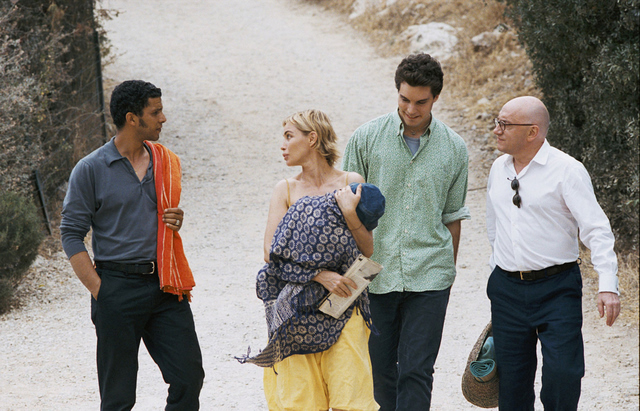MARCH 14, 2008
Some Kinds of Love
By Mark Jenkins

When We Go to the Beach: Bouajila, Béart, Libéreau, and Blanc in The Witnesses. (Strand Releasing)
ALTHOUGH IT'S DIRECTOR AND CO-WRITER André Téchiné's most gay-centric film since 1994's The Wild Reeds, THE WITNESSES is hardly a break with his customary mode or concerns. Near the movie's end, narrator Sarah (Emanuelle Béart) explains the structure of her in-progress novel: "The hub keeps shifting. Like in life." That's also a fine description of the filmmaker's approach in such recent ensemble dramas as Changing Times, which employ a fugue-like structure, large casts of characters, and sudden shifts in tone and circumstance.
It's common for Téchiné's recent films to feature Arab characters, who cross ethnic divides, and bisexual ones, who take similar forays through erotic identity. In The Witnesses, one man has both roles: Aggressive Franco-Arab vice cop Mehdi (Sami Bouajila) is Sarah's live-in boyfriend and the father of their somewhat neglected newborn. (Self-centered and highly sexual, Sarah hasn't taken to motherhood.) Mehdi then gets involved with young, openly gay Manu (Johan Libéreau), who becomes the story's pivot after he moves to Paris to live with his sister Julie (Julie Depardieu), an aspiring opera singer who lives in a cheap hotel whose other residents are mostly hookers.
It's summer 1984, and the young and reasonably handsome Manu begins a sexless relationship with Adrien (Michel Blanc), a middle-aged gay doctor who's Sarah's friend. At the beach with Adrien, Sarah, and Mehdi, Manu nearly drowns, and is rescued by the brusque cop. Mouth-to-mouth quickly moves beyond medical necessity, and soon the two men are lovers, if not exactly soulmates. Although the sex is not explicit, there's lots of it, and Béart, Bouajila, and Libéreau are frequently naked. Sarah and Mehdi have a non-monogamous relationship, and the film is open and sensuous in both mood and subject. Then Adrien notices that Manu is showing symptoms of a mysterious new disease associated with gay Americans. Jealous of Mehdi's relationship with Manu, Adrien can now take the boy away -- but to became his caretaker, not his boyfriend.
As usual with Téchiné, the narrative is intricate but fluid, shifting deftly between urgent and discursive passages. Less typical is that the movie employs a narrator, using Sarah's novel about Manu and his circle as voiceover commentary, and that it includes baldly didactic moments. Adrien becomes an angry advocate for AIDS patients, and in the film's middle section, his remarks serve as a ongoing lecture: "We're at war,'' he declares, while the other characters remain devoted to love (or, in Julie's case, music). This part of the film evokes the confusion, panic, and rage of the early AIDS era, yet ultimately the story is more about love and friendship than death. The final chapter's return to "summer" (both actually and figuratively) seems a little forced, but warmth and renewal suit the director's supple style better than outrage.
WRITER-PRODUCER-DIRECTOR TERRY SANDERS'S FIGHTING FOR LIFE interweaves what are essentially two different documentaries, one much more interesting than the other. Curiously, the dull one is structurally useful, since the more challenging film is hard to watch.
The rawer movie is an account of combat medicine in Iraq and followup treatment in Germany and D.C.; it's an unblinking survey of severe burns, shrapnel wounds, pulverized limbs, and missing digits. (The victims are mostly Americans, but include an Iraqi 3-year-old.) The footage is bloody and candid, full of details that will shock and anger. The other film is essentially a puff piece for the Bethesda medical school for military docs.
The Uniformed Services University of the Health Sciences is in perpetual danger of being defunded, and so Sanders was asked to make a film extolling its virtues. The result is worthy and bland, the kind of thing that ordinarily would be shown only at alumni reunions and recruitment fairs. Then the U.S. invaded Iraq, and the other movie presented itself. It confronts the hard questions, including the increasing survival -- thanks to body armor -- of appallingly mangled soldiers, the emotional strain of combat medicine, and the involvement of American physicians in torture of Iraqi suspects. It's rough going, which makes the film's other story something of a relief. The USU-HS propaganda is flat, but it's hard to imagine sitting though Fighting for Life without those breaks from the grisly OR action.